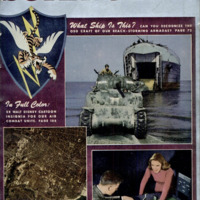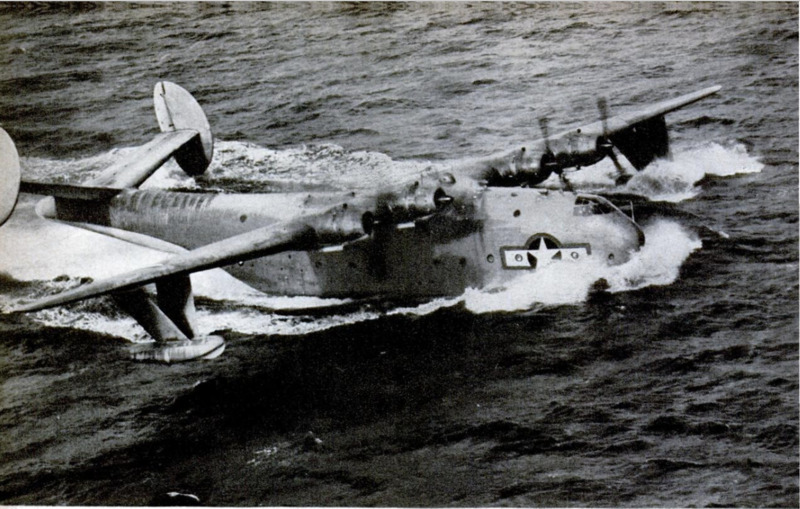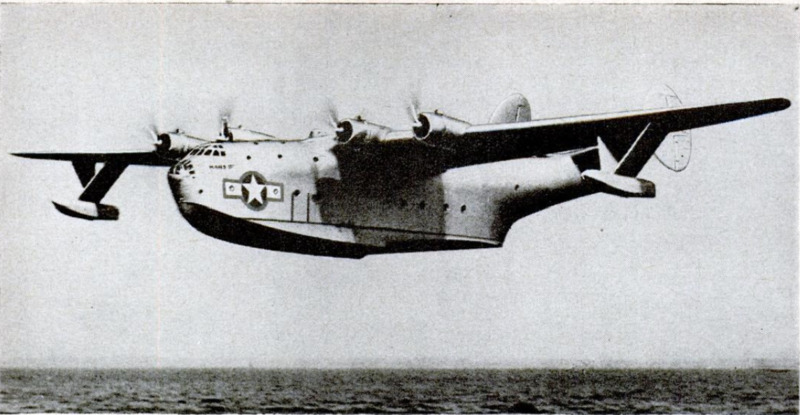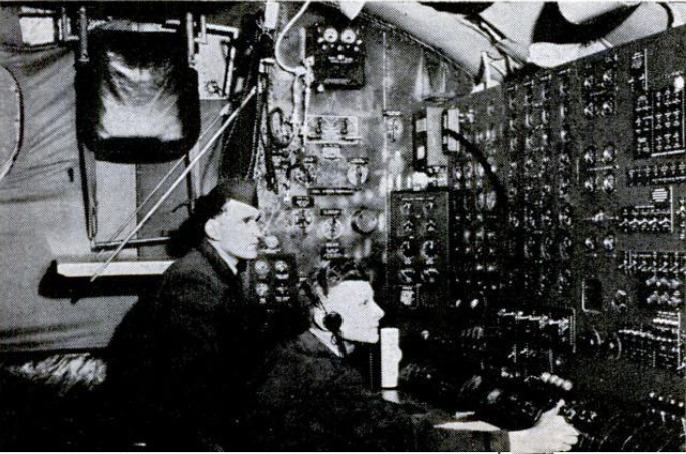-
Title (Dublin Core)
-
The Mars seaplane
-
Article Title and/or Image Caption (Dublin Core)
-
Title: The Mars makes good
-
Subtitle: Glenn. L. Martin's flying freighter join the Navy and proves her mettle on a first flight to Hawaii
-
extracted text (Extract Text)
-
PEARL HARBOR, HAWAII
WE DIDN'T come out to Hawaii just
the ride. We wanted to get the feel
of the peacetime airways that will circle the
globe after the war is won. We wondered
what kind of ships will take the long water
hops on those future trips. That's why we
jumped at the chance when the Navy offered
us permission to take this particular trip.
It was the first transocean flight in regular
service of the giant seaplane Mars.
Every one of the 35 people aboard the
huge flying boat had a few lurking doubts
as she cast off her moorings at the Alameda
Naval Air Station on San Francisco Bay.
Only a fool would be confident on the maiden
voyage of any ship of radically new design,
and the Mars is by far the biggest aircraft
in regular service. One hundred seventeen
feet from stem to stern, 200 feet from wing
tip to wing tip, the huge whale-shaped hull
designed by Glenn L. Martin's engineers has
as much room inside as a 15-room house.
The Navy's biggest “flying boxcars,” the
Coronado PB2Y's, are only a little more
than half her size. It would take three giant
Douglas C-54’s to move as much freight or
as many passengers as the Mars can tote on
a 2,500-mile hop. It was a lot of airplane
that Skipper Bill Coney had to lift off of
San Francisco Bay on that clear evening of
January 22—about 75 tons of plane, gas,
crew, and cargo.
We cruised south over the surface of the
bay with the four big Whirlwinds still warm-
ing. They are of a new type perfected dur-
ing the Mars’ first trials. Then the skipper
brought her about, and we picked up speed
as the nose pointed north. The ship bucked
gently against the waves slapping her bow.
We passengers were snug in the after
compartment, lower deck, behind the last
but one of seven watertight bulkheads that
divide the deck into compartments. High
above us and forward on the flight deck,
Lieutenant Hamilton, the chief engineering
officer, must have pulled all four throttles
wide open. The four engines gave out with
the full roar of more than 9,000 horsepower.
The interphone gave warning: “Stand by
for take-off.”
The starboard ponton lifted clear of the
water. Up in the cockpit Skipper Coney
was trying her for balance. Spray blanketed
our portholes. The wings waggled once as
we lifted into a quartering wind, then all
feeling of motion ceased. There was only
the roar and vibration of the engines. The
take-off was perfect. Seasoned flyers were
amazed at the ease With which the big sea
bird took the air.
But, just to remind you that the Mars is
a big ship, that take-off run was a mile and
a half long. And, just to remind those of
us aboard that she was a new ship with
her reputation still to make, a regular Navy
seaplane tailed us all the way across—
just in case.
‘The sun had dipped behind the Golden
Gate before we left the water, but at 5,000
feet we saw it again. At that altitude—
though the skipper is firm about keeping his
ship in perfect balance—we could shuck our
life jackets and begin to move about the
ship by twos and fours.
Because of her sheer, overpowering size
and the uncanny steadiness of her flight, it's
hard to remember at times that the Mars
is not a ship but a plane.
As you leave the waist compartment and
move forward along the main passageway of
the lower deck, you enter the galley through
a watertight bulkhead. Another bulkhead,
and then a bunk room. Forward of that is
the main cargo hold with five tons of
precious war material lashed tight on either
side of the passageway. Then the fueling
compartment, from which lines lead to the
fuel tanks under the lower deck. Together
the tanks have room for as much high-
octane gasoline as a fully loaded tank car.
Forward of the fueling room is another
bunk room. To port is a fully equipped
‘washroom and shower; to starboard, a ladder
that leads to the flight deck above. Up in
the nose, under the flight deck, are well-
appointed quarters for the officers.
‘The Mars has an interesting history—and
shows it. Her keel was laid at Baltimore
before Pearl Harbor, but she had been
planned originally as a long-range bomber.
With a theoretical range of 8,000 miles, she
might have been able to take off from
Hawai, drop 20 tons of bombs on Tokyo,
and return to Pearl Harbor, but the lessons
of blitzkrieg taught that a bomber has to
be something besides a big truck.
The Mars is not a particularly fast ship;
she hasn't nearly the speed of one of the
newest Fortresses. So the big bomb bays
in her wings were changed into cargo holds.
Next, the Navy had her marked for person-
nel transport. Finally, she proved perfect
as a heavy freighter with room for plenty of
passengers in addition to cargo. Today she
carries no armament, but the machine-gun
blister out in her tail is a reminder that she
has been a flying laboratory for the lessons
of modern war.
As a result of that history of trial and
error, more ships of the Mars type will
soon be coming from the production line. A
score of them will eventually join the Navy's
NATS squadrons—the force that rushes
Navy men and vital material out to the
battle fronts far from home.
You can go up inside the wings, where
the bomb bays were to have been. You
climb a gangway in the waist compartment.
Upstairs you find yourself in a bunk room.
In a second bunk room forward is a short
flight of stairs. At the top, you open a
bulkhead and ease yourself gingerly inside,
above the fuselage. You can stand without
stooping inside the wing. Once each hour
one of the 15 crew members climbs up here;
makes his way among the tubular internal
braces of the wing; inspects engines and
fuel, oil, and ignition lines; looks over the
hydraulic pressure lines that operate the
“booster” on the automatic controls.
The more you see of her, the more the
size of old “Moby Dick” impresses you.
You keep comparing the size of things with
that of the equipment of ordinary planes.
Every so often you have to stop and remind
yourself that the big winged whale is really
purring along over the Pacific, cruising at
between 8,000 and 9,000 feet, smooth as a
Buick rolling over asphalt, quiet as an aver-
age “stateside” airliner, though only parts
of the ship are soundproofed.
Somewhere out over the Pacific, Lt. Ken
Winsor, the third pilot, drops down to the
waist compartment for a smoke.
“Anybody here seen my flight jacket?”
he asks. Passengers and crewmen shake
their heads. “See this.” He takes off his
knitted scarf. “I just found this after a
month.” Yes, you can lose your stuff on a
ship as big as the Mars.
It's up on the flight deck that the really
important work goes on. With plenty of
headroom, it’s as big as an average living
room. As you step off the ladder, the engi-
neer on duty sits at your left with his back
to you, facing two panels loaded with about
150 dials and controls. Up ahead of him, the
two navigators work over their charts and
data spread over a table seven feet long
by three wide. Still farther forward is a
small work table for the flight engineer, and
over to the right sits the radioman. Because
the lights burn all night on the flight deck,
a black curtain separates it from the cock-
pit up In the nose. Aft is a turret not un-
like the top turret on a bomber, where the
navigator can get a fix on a star in any
direction. Standing up there, you feel you
have never been so close to the stars. Be-
sides those stars, only the tail light, the
violet flame pouring from the exhaust ports,
and the red-hot exhaust manifolds remind
you where you are.
Some of us expected excitement on the
Mars’ first Pacific flight. We were disap-
pointed. The ride was as smooth as velvet.
Even when we went up to 9,500 to ride over
the top of a storm, there were hardly enough
bumps to remind us that we were in an
airplane. The Mars, say all three of her
veteran pilots, handles more easily than
any other plane they ever flew. They boast
that she can climb with a full load on any
two of her engines, and she can land with
all of them cut out.
Incidentally, Bill Coney is a former flight
captain for Eastern Alrlines, and his two
copilots on the Mars flew with him in com-
mercial airline work.
This was the skipper's first flight to
Hawaii, and he wanted to set the Mars down
in daylight. She's the first of her kind, far
too valuable to take chances with. In many
ways, she's still a flying laboratory piling
up valuable data.
Though nothing was visible of blacked-
out Hawaii below, the line on the big chart
showed we had nearly reached the island of
Molokai. Navigator Witherspoon and the
skipper bent over the big chart-table. Unless
we were to land in darkness, we had nearly
two hours of flying time to kill, so we turned
right on a dog-leg north of Molokai and just
idled along for three quarters of an hour or
so. When we turned south again, the South-
ern Cross hung low in the sky over Molokai
—an auspicious welcome to Hawaii.
We flew in close to Oahu and circled.
Then, dropping altitude without a quiver, we
swung around Diamond Head and slid into
Honolulu Harbor just as the sun was rising.
“Stand by for landing!”
This time we didn’t bother to put on life
jackets. As far as we were concerned, old
“Moby Dick” had made good. With never
a bump, we landed on the glassy surface
and taxied up to our berth.
The navigator’s clock showed 7:42. Chas-
ing the sun, we'd gained 21; hours on the
clock, and our flying time for the trip was
15 hours nine minutes. We knew that with
equally good weather Bill would make it
next time in about 13.
Out here in Hawaii they stop you in the
street to ask questions when they learn you
came over in the Mars. Hawaii is aching to
know all that military secrecy will permit
to be known about the planes that speed
passengers and cargo across the vast
reaches of the Pacific.
Today, Hawaii teems with uniforms. She
is the great advance base in our island-to-
island campaign as it gathers strength to
drive the Japs from the South Pacific and
back upon the Land of the Rising Sun.
Pearl Harbor and Hickam Field are among
the greatest air bases in the world. A never-
ending line of planes and ships cuts across
the 2,400 miles that separate these islands
from the mainland, and from these islands
other lines stretch out like fingers to every
point where American troops are fighting
in the Pacific. When peace comes, Hawaii
will again be what she used to be—the
crossroads of commercial traffic between
us and the Orient.
Hawaii knows that flying is here for all
time. The war has made this island people
intensely air-minded. Steamship companies
are already planning to supplement their
service with fast air lines. They speak of
bringing passengers from the mainland here
by air for as little as $125, and Hawaiians
are intent on learning what kind of ships
will be landing here in those days to come.
Some believe they will be big land planes
like the Douglas C-54, or big, fast ships like
the Liberator, which can span the distance
to the mainland in nine hours. But many
feel they will be giant sea birds like the
Mars. They point out that the big land
transports must carry four or more tons of
landing gear not needed on an ocean hop,
that they are voracious gas-eaters; that
they require tremendous, deep-laid runways
on which to land with a full load, while the
big flying boats can land on any good-
sized lagoon—of which there are many not
only in these islands but all through the
South Pacific.
Not very fast, but roomy and comfort-
able, able to carry far more weight than
any other plane yet seen, ships like the Mars
may be our luxury airliners for transocean
travel after the war.
-
Contributor (Dublin Core)
-
Alfred H. Sinks (article writer)
-
Language (Dublin Core)
-
eng
-
Date Issued (Dublin Core)
-
1944-04
-
pages (Bibliographic Ontology)
-
82-84, 204, 208
-
Rights (Dublin Core)
-
Public Domain (Google digitized)
-
Archived by (Dublin Core)
-
Lorenzo Chinellato
-
Marco Bortolami (editor)
-
Spatial Coverage (Dublin Core)
-
Hawaii
 Popular Science Monthly, v. 144, n. 4, 1944
Popular Science Monthly, v. 144, n. 4, 1944








